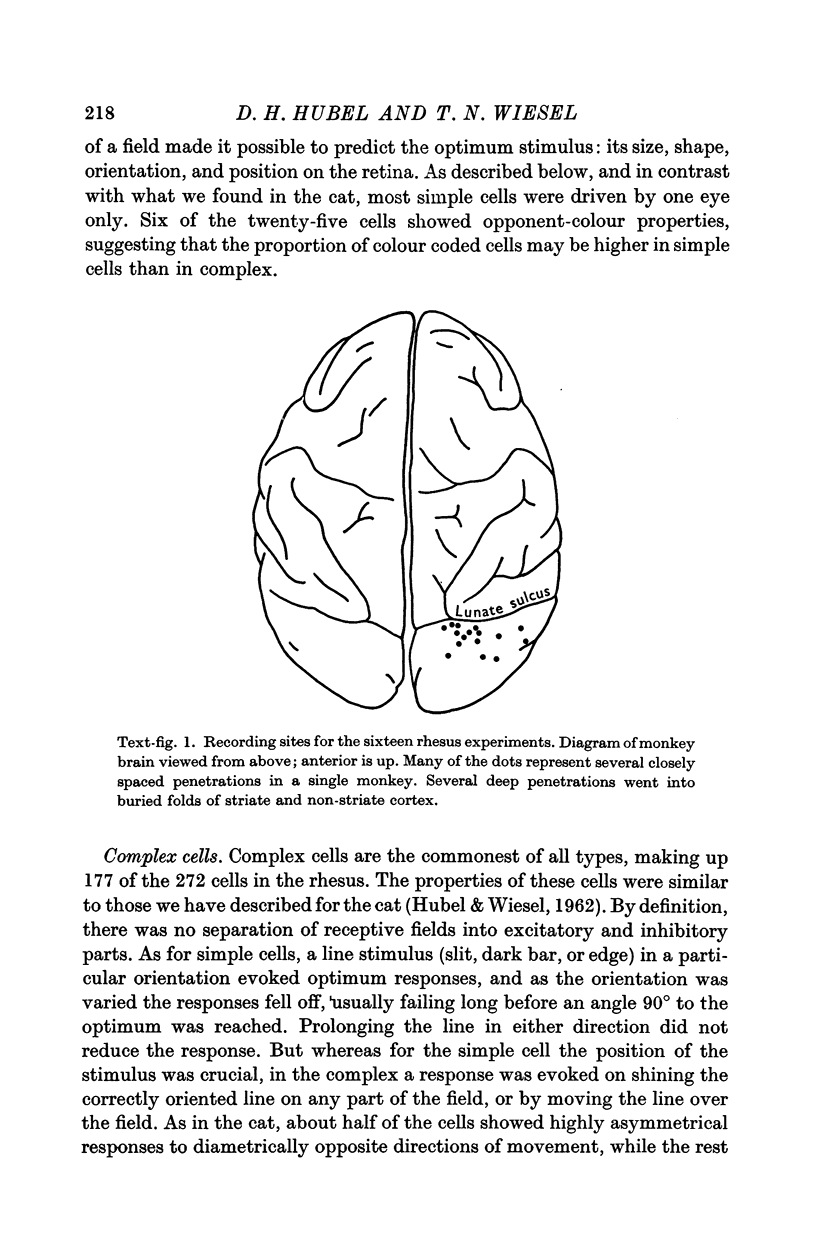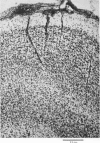Abstract
1. The striate cortex was studied in lightly anaesthetized macaque and spider monkeys by recording extracellularly from single units and stimulating the retinas with spots or patterns of light. Most cells can be categorized as simple, complex, or hypercomplex, with response properties very similar to those previously described in the cat. On the average, however, receptive fields are smaller, and there is a greater sensitivity to changes in stimulus orientation. A small proportion of the cells are colour coded.
2. Evidence is presented for at least two independent systems of columns extending vertically from surface to white matter. Columns of the first type contain cells with common receptive-field orientations. They are similar to the orientation columns described in the cat, but are probably smaller in cross-sectional area. In the second system cells are aggregated into columns according to eye preference. The ocular dominance columns are larger than the orientation columns, and the two sets of boundaries seem to be independent.
3. There is a tendency for cells to be grouped according to symmetry of responses to movement; in some regions the cells respond equally well to the two opposite directions of movement of a line, but other regions contain a mixture of cells favouring one direction and cells favouring the other.
4. A horizontal organization corresponding to the cortical layering can also be discerned. The upper layers (II and the upper two-thirds of III) contain complex and hypercomplex cells, but simple cells are virtually absent. The cells are mostly binocularly driven. Simple cells are found deep in layer III, and in IV A and IV B. In layer IV B they form a large proportion of the population, whereas complex cells are rare. In layers IV A and IV B one finds units lacking orientation specificity; it is not clear whether these are cell bodies or axons of geniculate cells. In layer IV most cells are driven by one eye only; this layer consists of a mosaic with cells of some regions responding to one eye only, those of other regions responding to the other eye. Layers V and VI contain mostly complex and hypercomplex cells, binocularly driven.
5. The cortex is seen as a system organized vertically and horizontally in entirely different ways. In the vertical system (in which cells lying along a vertical line in the cortex have common features) stimulus dimensions such as retinal position, line orientation, ocular dominance, and perhaps directionality of movement, are mapped in sets of superimposed but independent mosaics. The horizontal system segregates cells in layers by hierarchical orders, the lowest orders (simple cells monocularly driven) located in and near layer IV, the higher orders in the upper and lower layers.
Full text
PDF































Images in this article
Selected References
These references are in PubMed. This may not be the complete list of references from this article.
- Campbell F. W., Kulikowski J. J. Orientational selectivity of the human visual system. J Physiol. 1966 Nov;187(2):437–445. doi: 10.1113/jphysiol.1966.sp008101. [DOI] [PMC free article] [PubMed] [Google Scholar]
- DANIEL P. M., WHITTERIDGE D. The representation of the visual field on the cerebral cortex in monkeys. J Physiol. 1961 Dec;159:203–221. doi: 10.1113/jphysiol.1961.sp006803. [DOI] [PMC free article] [PubMed] [Google Scholar]
- Dowling J. E., Boycott B. B. Organization of the primate retina: electron microscopy. Proc R Soc Lond B Biol Sci. 1966 Nov 15;166(1002):80–111. doi: 10.1098/rspb.1966.0086. [DOI] [PubMed] [Google Scholar]
- HUBEL D. H. Cortical unit responses to visual stimuli in nonanesthetized cats. Am J Ophthalmol. 1958 Sep;46(3 Pt 2):110–122. doi: 10.1016/0002-9394(58)90060-6. [DOI] [PubMed] [Google Scholar]
- HUBEL D. H. Single unit activity in striate cortex of unrestrained cats. J Physiol. 1959 Sep 2;147:226–238. doi: 10.1113/jphysiol.1959.sp006238. [DOI] [PMC free article] [PubMed] [Google Scholar]
- HUBEL D. H., WIESEL T. N. RECEPTIVE FIELDS AND FUNCTIONAL ARCHITECTURE IN TWO NONSTRIATE VISUAL AREAS (18 AND 19) OF THE CAT. J Neurophysiol. 1965 Mar;28:229–289. doi: 10.1152/jn.1965.28.2.229. [DOI] [PubMed] [Google Scholar]
- HUBEL D. H., WIESEL T. N. Receptive fields of optic nerve fibres in the spider monkey. J Physiol. 1960 Dec;154:572–580. doi: 10.1113/jphysiol.1960.sp006596. [DOI] [PMC free article] [PubMed] [Google Scholar]
- HUBEL D. H., WIESEL T. N. Receptive fields of single neurones in the cat's striate cortex. J Physiol. 1959 Oct;148:574–591. doi: 10.1113/jphysiol.1959.sp006308. [DOI] [PMC free article] [PubMed] [Google Scholar]
- HUBEL D. H., WIESEL T. N. Receptive fields, binocular interaction and functional architecture in the cat's visual cortex. J Physiol. 1962 Jan;160:106–154. doi: 10.1113/jphysiol.1962.sp006837. [DOI] [PMC free article] [PubMed] [Google Scholar]
- HUBEL D. H., WIESEL T. N. Shape and arrangement of columns in cat's striate cortex. J Physiol. 1963 Mar;165:559–568. doi: 10.1113/jphysiol.1963.sp007079. [DOI] [PMC free article] [PubMed] [Google Scholar]
- Hubel D. H. Tungsten Microelectrode for Recording from Single Units. Science. 1957 Mar 22;125(3247):549–550. doi: 10.1126/science.125.3247.549. [DOI] [PubMed] [Google Scholar]
- Hubel D. H., Wiesel T. N. Binocular interaction in striate cortex of kittens reared with artificial squint. J Neurophysiol. 1965 Nov;28(6):1041–1059. doi: 10.1152/jn.1965.28.6.1041. [DOI] [PubMed] [Google Scholar]
- MOTOKAWA K., TAIRA N., OKUDA J. Spectral responses of single units in the primate visual cortex. Tohoku J Exp Med. 1962 Dec 25;78:320–337. doi: 10.1620/tjem.78.320. [DOI] [PubMed] [Google Scholar]
- MOUNTCASTLE V. B. Modality and topographic properties of single neurons of cat's somatic sensory cortex. J Neurophysiol. 1957 Jul;20(4):408–434. doi: 10.1152/jn.1957.20.4.408. [DOI] [PubMed] [Google Scholar]
- Wiesel T. N., Hubel D. H. Spatial and chromatic interactions in the lateral geniculate body of the rhesus monkey. J Neurophysiol. 1966 Nov;29(6):1115–1156. doi: 10.1152/jn.1966.29.6.1115. [DOI] [PubMed] [Google Scholar]





